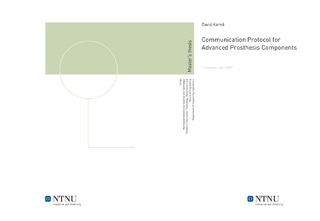Communication Protocol for Advanced Prosthesis Components
Master thesis
Permanent lenke
http://hdl.handle.net/11250/259864Utgivelsesdato
2007Metadata
Vis full innførselSamlinger
Sammendrag
It would be of great value for the prosthesis industry to achieve an open standard for communication in upper limb prostheses. Cooperation between NTNU and the University of New Brunswick has resulted in a functional requirements specification for such a standard, SCIP(Standardised Communication Interface in Prostheses). The special challenges for communication in a prosthesis system are possible noisy environments, high demands for light weight, safety for the user and the fact that devices might be switched during operation. It was the purpose of this master thesis to make a design based upon those requirements. This was done by first choosing an existing bus standard, that would provide the lower levels of communication. CAN was chosen for this purpose. The next step of the design process was to transform the functional requirements into more specific technical requirements. This resulted in the definition of four types of nodes on the bus. These are bus controller, input controller, device controller and service controller. Their interactions called for the specification of several different message types, to support data exchange between the nodes. The result was a design that specifies node types, message types, variables like adresses, control strategies etc., state transition diagrams for the different node types and some message sequences. It also specifies the use of the CAN data-frame for all message types.
